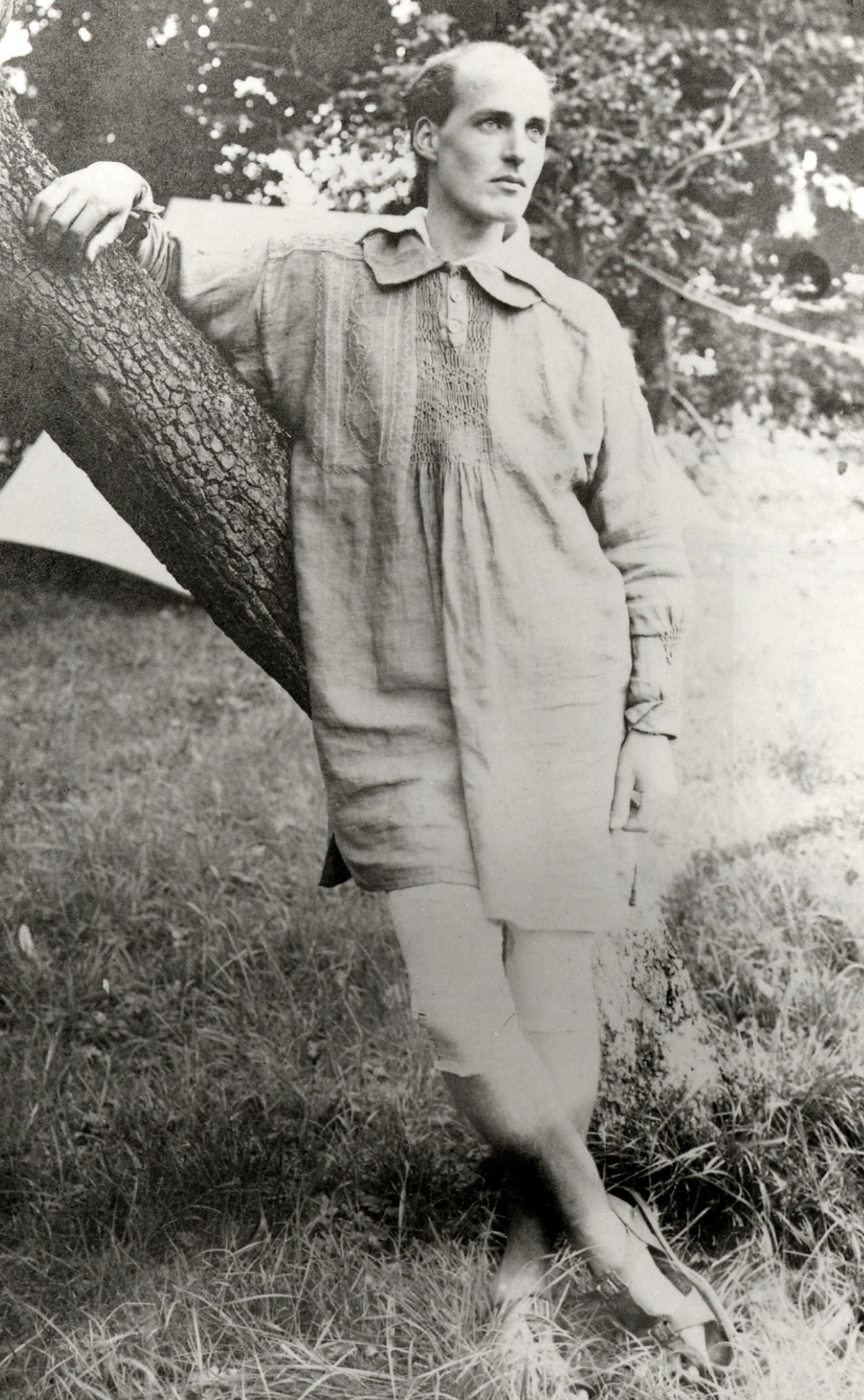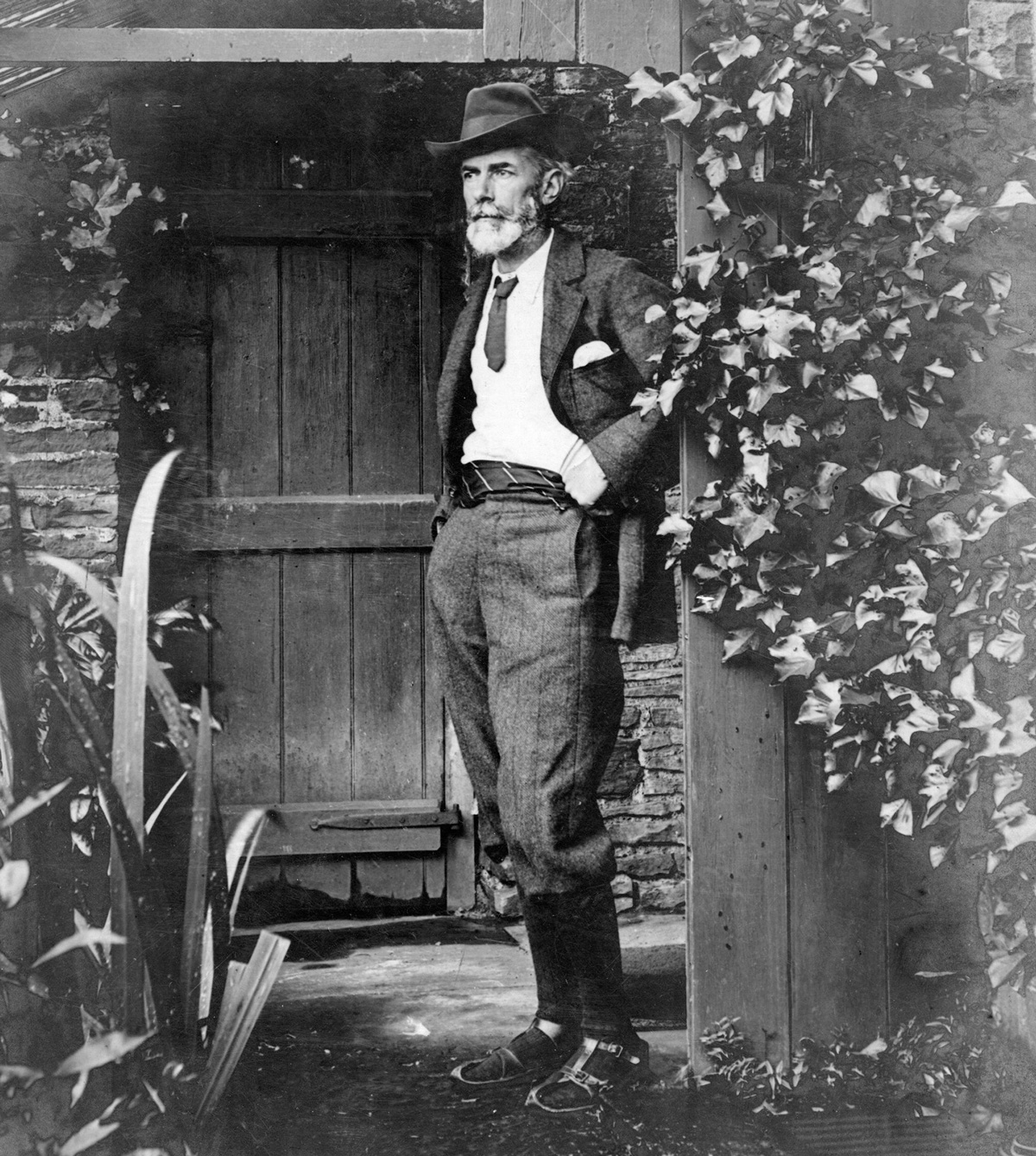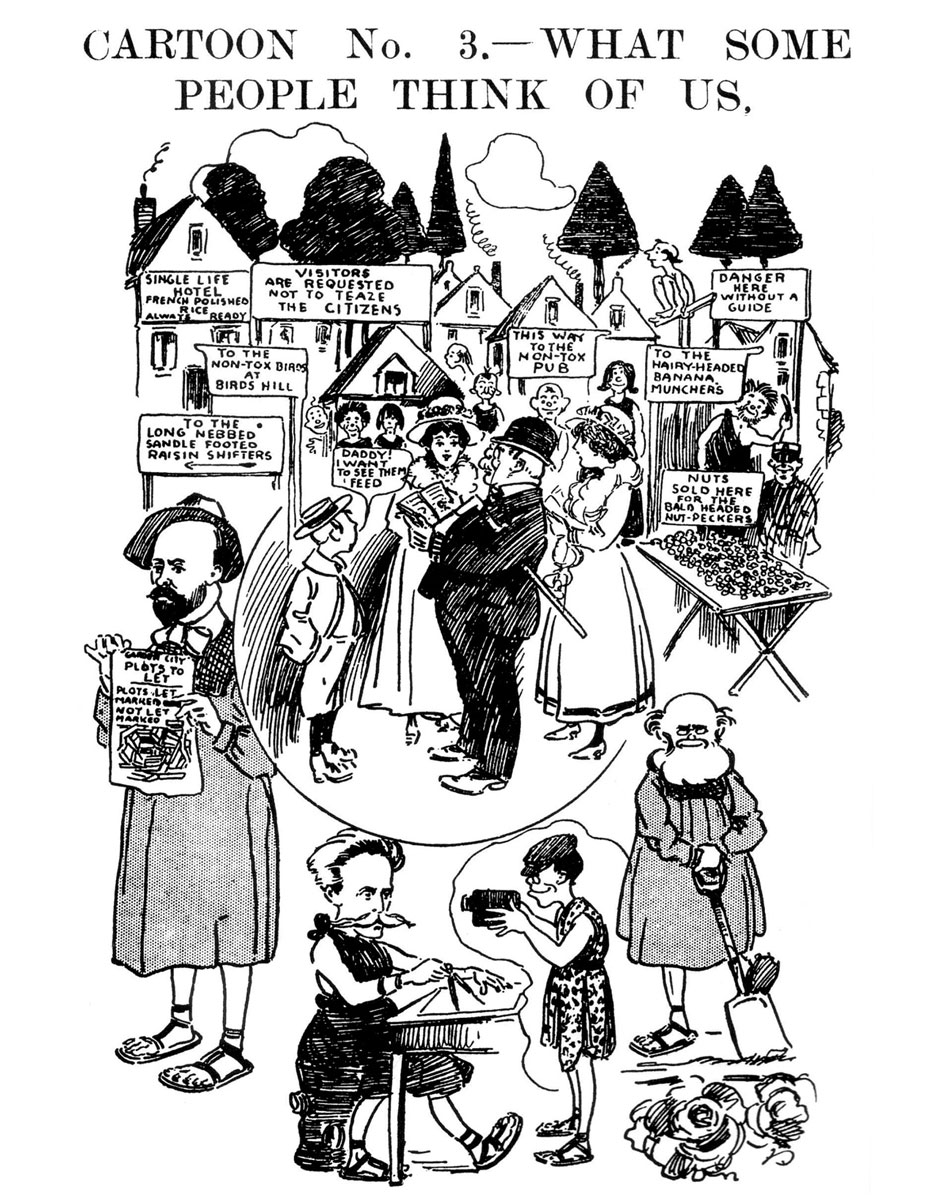A Brief History of Cranks
On bearded fruit juice drinkers, nudists, and sandal-wearers
Paul Laity
“Socialism,” George Orwell famously wrote in The Road to Wigan Pier (1936), draws towards it ”with magnetic force every fruit-juice drinker, nudist, sandal-wearer, sex-maniac, Quaker, ‘Nature Cure’ quack, pacifist and feminist in England.” His tirade against such “cranks” is memorably extended in other passages of the book to include “vegetarians with wilting beards,” the “outer-suburban creeping Jesus” eager to begin his yoga exercises, and ”that dreary tribe of high-minded women and sandal-wearers and bearded fruit-juice drinkers who come flocking towards the smell of ‘progress’ like bluebottles to a dead cat.”

The stereotyping and caricaturing of middle-class “cranks” goes deep in English national culture. Throughout the nineteenth century, Punch magazine lampooned health obsessives who sought a purer life in boiled cabbage and teetotalism. An Aldous Huxley story, “The Claxtons,” which anticipates much of Orwell’s philippic, portrays a puritanical, radical, self-deceiving bourgeois family: “In their little house on the common, how beautifully the Claxtons lived, how spiritually! Even the cat was a vegetarian.” And earlier this year the right-wing tabloid Daily Mail derided the Guardian (not for the first time, no doubt) as being run by (and for) “sandal-wearing folk.” It’s a gibe that’s still meant to suggest the things it did in Orwell’s day: woolly-headed naivety, moral superiority, and worthy bohemianism—certainly a world beyond the values of a mythical “real” England of ordinariness and decency.
Orwell’s savage send-ups of “cranks” betray some anxiety about sexual freedom but usually make straight for the obvious target—their earnestness. Cranks want the world to become a less cruel, less crassly commercial, more beautiful place. Their pleasures are wholesome, “natural,” and energetic. (When I was growing up, my parents would refer to certain people as very “brown rice and bicycles.”) According to the cartoon version of countercultural progressives, they are desperate for everything to be health-giving and improving. So one of Orwell’s figures of fun is a “hangover from the William Morris period” who proposes to “level the working class ‘up’ (up to his own standard) by means of hygiene, fruit-juice, birth-control, poetry, etc.” In his novel Coming Up For Air (1939), we encounter “Professor Woad, the psychic research worker”: “I knew the type. Vegetarianism, simple life, poetry, nature-worship, roll in the dew before breakfast … They’re all either health-food cranks or else they have something to do with the boy scouts—in either case they’re great ones for Nature and the open air.”
Orwell’s satire in The Road to Wigan Pier was employed in a particular and urgent cause: the fashioning of a popular (non-crankish), common-sense radical politics to face the growing threat of Fascism. (Soon after handing the manuscript of the book to his publisher, Victor Gollancz, he began his journey to Barcelona to fight for the Republicans in the Civil War.) In his view, cranks—along with “shock-headed Marxists chewing polysyllables”—were giving socialism a bad name. He also implied that they were only superficially committed to the socialist cause, and ultimately concerned more about their own moral purity than about the exploitation of the working class. But who exactly did Orwell have in mind when he let loose his invective? Who were the cranks?
He chose never to mention in print that he had himself mixed with many countercultural types, including his aunt, Nellie Limouzin—a bohemian whose husband was a socialist and stalwart of the Esperanto movement—and the Westropes, who owned the bookshop in Hampstead where he worked in the mid-1930s. Francis Westrope had been a conscientious objector in the war and was a member of the Independent Labour Party; his wife, Myfanwy, campaigned for women’s rights—both were keen Esperantists. His backer Mabel Fierz, too, lived in a big house in Hampstead Garden Suburb and leaned towards a mystical and spiritual socialism.
Friends and family members no doubt influenced Orwell’s portrait to some extent, but he had a whole politico-cultural tradition in his sights. This stretched back at least as far as the millennial socialist sects of the 1830s and 1840s, inspired by the reformer Robert Owen and his newspaper the New Moral World. “Cranks” were much in evidence in these model communities—Catherine and Goodwyn Barmby, for instance, who became impatient with the imperfectly purist tone of the Owenite movement, and formed the Communist Church (its sister organisations included the White Quakers in Dublin and the Ham Common Concordium in Richmond). They preached various New Age prophecies, along with vegetarianism, hydrotherapy, long hair, and sandal wearing. Over the years, Goodwyn Barmby became a Christ-like figure, with blonde hair down to his shoulders; together the young couple walked the London streets with a cart from which they dispensed tracts and harangued passersby.
The late nineteenth-century socialist revival was heavily invested in “crankish” beliefs. As Michael Holroyd has written, it was largely “from agnostics, anarchists and atheists; dress and diet reformers; from economists, feminists, philanthropists, rationalists and spiritualists, all striving to destroy or replace Christianity” that the revival was drawn. The firebrand Henry Hyndman, a disciple of Engels and founder of the Social Democratic Federation (SDF) in 1881, despaired, like Orwell, of this kind of moral faddism. “I do not want the movement,” he asserted, “to be a depository of old cranks, humanitarians, vegetarians, anti-vivisectionists, and anti-vaccinationists, arty-crafties and all the rest of them.” Not surprisingly, William Morris and his friends in the SDF decided to secede and in 1884 formed their own group, the more anarchical (and sexually radical) Socialist League. The Fabian Society, begun at the same time, was an outgrowth of the ethical-spiritual (and meat renouncing) Fellowship of the New Life. This was also the age of the Vegetarian Cycling Society and the socialist Clarion Field Clubs, which aimed “to bring the town dweller more frequently into contact with the beauty of nature: to help forward the ideal of the simpler life, plain living and high thinking.” George Bernard Shaw, who, as a vegetarian and wearer of unbleached and knitted natural wool, had a close relationship with crankery, summed up the two different impulses in the socialism of the time: one was to “organise the docks,” the other to “sit among the dandelions.”
The patron saint of the dandelion-sitters was Edward Carpenter, and Orwell clearly had him in his thoughts. A former curate, a guest of Thoreau, and the author of a long Whitmanesque poem, Towards Democracy, Carpenter exhorted a spiritual socialism and a return to nature. As a result of a vision, he bought a smallholding at Millthorpe, near Sheffield, where he grew his own food. He was a vegetarian and an advocate of birth control and Eastern mysticism; he also wrote The Intermediate Sex, the first book generally available in Britain to shine a positive light on gay sex. He used to bathe naked at dawn with his manservant and lover, and his life was denounced as scandalous and immoral.

More than anyone else, Carpenter was also responsible for introducing sandals to British life. When his friend Harold Cox went to India, he was given instructions to send back to Millthorpe a pair of sandals from Kashmir. The pair in question featured a thong that curled up from the sole over the toes to an ankle fastening. “I soon found the joy of wearing them,” Carpenter wrote. “And after a little time I set about making them.” Shoes, he decided, were “leather coffins.” He took lessons from a Sheffield bootmaker and “soon succeeded in making a good many pairs for myself and various friends.” (Shaw was given some, but they cut his feet and he vowed never to wear them again.) Various disciples made the pilgrimage to Millthorpe, including, Carpenter remembered, one woman dress-reformer—“her name was Swanhilda something“—who walked miles in the pouring rain, wearing a roughly cut blue serge dress and sandals which kept getting stuck in the mud. One of Carpenter’s employees at Millthorpe, George Adams, also took up sandal-making. When he fell out with his master, he moved to the newly established Letchworth Garden City, in Hertfordshire, and established a small sandal business there.
Letchworth has a special place in the history of crankery. “One day this summer,” Orwell writes in The Road to Wigan Pier, “I was riding through Letchworth when the bus stopped and two dreadful-looking old men got onto it. They were both about sixty, both very short, pink and chubby, and both hatless. … They were dressed in pistachio-coloured shirts and khaki-shorts into which their huge bottoms were crammed so tightly that you could study every dimple. Their appearance created a mild stir of horror on top of the bus. The man next to me … murmured ‘Socialists.’” “He was probably right,” the passage continues. “The Independent Labour Party were holding their summer school in the town.” (Orwell neglects to say that he was attending it.)
Letchworth Garden City, established in 1904 as an experiment in town planning—a utopia of pure air and rational living—instantly became a mecca for simple-lifers and acquired a nationwide reputation for “crankishness”: sandals and scandals. One of its two original architects, Raymond Unwin, was a former associate of Carpenter’s within Sheffield socialism (and a vegetarian). An early resident offered a description of the “typical Garden citizen,” who wore sandals, ate no meat, read William Morris and Tolstoy, and kept two tortoises “which he polished periodically with the best Lucas oil.” The vegetarians in the town opened the Simple Life Hotel, which had a health-food shop and a food reform restaurant. A member of the Quaker Cadbury family started up an alcohol-free pub, the Skittles Inn, which did a brisk trade in hot chocolate and Cydrax, a non-intoxicating apple wine. (This inspired G. K. Chesterton’s comment about a life which is all skittles and no beer, and later John Betjeman’s raillery in Huxley Hall: “Not my vegetarian dinner, not my lime juice minus gin, / Quite can drown a faint conviction that we may be born in Sin.”) Londoners, on their Sundays off, made special excursions by train to study Letchworth’s strange collection of smock-wearing Esperanto speakers and theosophists: a cartoon from a local newspaper showed day-trippers at a human zoo. “Daddy, I want to see them feed!” pleads a child. Signs for visitors include: “To the Long Nebbed Sandal Footed Raisin Shifters,” “This Way to the Non-Tox Pub,” and “To the Hairy-Headed Banana Munchers.” Annie Besant, a theosophist and campaigner for birth control, opened the St. Christopher School—where the Independent Labour Party gathering was held—and which today still offers only vegetarian food (its pupils admit to nipping out to McDonald’s).

The 1920s and 1930s offered plenty of countercultural trends to cause Orwell more immediate alarm. Pacifism of an absolutist kind was more generally espoused in the early to mid-1930s than at any other time in British history. There was also a craze for the open air (associated with an increase in leisure) and for a hygienic, wholemeal lifestyle. The membership of the Clarion Cycling Club reached a peak in the mid-1930s, and unprecedented numbers of city dwellers in knickerbockers and open-necked shirts took to youth hostelling and rambling with high-minded verve. “Freedom to roam” over dales and moors became a left-wing issue, and mass hiking a political act, sometimes combined with a touch of nature mysticism. In 1932, the writer S. P. B. Mais led sixteen thousand people out onto the South Downs one morning to see the sun rise over Chanctonbury Ring (unfortunately, it was cloudy). The back-to-nature movement assumed other forms, too. The Nature Cure Clinic was opened in Marylebone in 1928, taking its homeopathic ideas from the East via Germany. Raw fruit and vegetable juices were championed as essential for removing toxins from the body. And it was in the 1930s that Dr. Edward Bach argued for the healing effects of the flower essences he had found while collecting dewdrops from plants at dawn.
Organized nudism first appeared in Britain in the late 1920s. One of the first resorts to open was Sun Lodge in Upper Norwood, southeast of London. From 1928, members of the Sun Bathing Society would meet at weekends to soak up the invigorating, health-giving rays and enjoy other activities such as “rhythmic dancing.” Locals would gather around the boundary fence trying to catch a glimpse of the bathers in puris naturalibus. In 1929, the police were called in at the Welsh Harp Reservoir near Wembley to protect naturists from rioters. In spite of the controversy it attracted, the nudity movement gathered strength. A letter to the Times in 1932 called for recognition of the benefits of sun-worshipping “in less than a bathing costume.” Its signatories included Shaw and C. E. M. Joad, popular philosopher, socialist, pacifist, countryside enthusiast (and perhaps the model for Orwell’s “Professor Woad”). Joad was convinced of the healthiness of lying “naked to the sun,” if only in deserted coves. Ridicule was never far away. In the film I See Ice (1938), George Formby sang of having “A picture of a nudist camp / In my little snapshot album. / All very jolly but a trifle damp / In my little snapshot album.”
Leslie Paul, founder of the Woodcraft Folk, an anti-militarist alternative to the scouts, which was open to both boys and girls, described himself as “a socialist of the Edward Carpenter stamp, in love with a mystical vision of England.” In 1933, five hundred young members of the Folk camped around a large Bronze Age standing stone in Herefordshire to hear a lecture on ley lines while two boys crouched in wicker cages on top of the monument. (Today, the owner of the land on which the Queen Stone sits prefers its exact location not to be publicized so as to discourage the holding of séances.) Paul, a writer and journalist, spent much of his time in a cottage in rural Devonshire. A local friend, Joe, his “taut and curly” chest hair like a “wire mattress,” would sunbathe naked for hours a day while declaring his Tolstoyism and denouncing leather shoes. “Vegetarianism was in the progressive air,” Paul later wrote. “New food shops catered for fantastic new-life tastes. … I drank a mixture of malted milk, hot water and olive oil which was held to have the most beneficial effects on one’s colon and nerves.” He was an admirer of the Soviet Union, a socialist, and a pacifist. “Pacifism had an extraordinary affinity for vegetarianism,” he reflected, “and so we lived on enormous wooden bowls of garlic-flavoured salad, and messes of lentils and roasted pine-kernels garnished with leeks. We thrived.”
Orwell attended two socialist summer schools in 1936: the one in Letchworth and another, held at a large house in Langham, near Colchester, which was organized by the Adelphi, a magazine he reviewed for. The journal’s founding editor was the critic John Middleton Murry, a pacifist and socialist of a spiritual, poetic kind, who acquired the countryside house in the hope that it would become the nucleus of a new form of egalitarian community. (“In that simple and beautiful place, our socialism became a reality,” he wrote. “It felt to me as though we had attained a new kind of immunity from illusion.”) All the guests were asked to help in the center’s running: Orwell was in demand as a dishwasher, using skills he had developed while down and out in Paris. During one of the discussions he apparently told the mostly middle-class audience that they wouldn’t “recognise a miner or a docker if they came into the room.” Murry eventually came to believe that the Adelphi Centre was too much of a talking shop: the socialists staying there lacked the discipline imposed by tough physical work. His next project was a pacifist farm.
There are hundreds of other examples of simple-life socialists who would have provoked Orwell’s scorn. And, despite his best efforts, the long and rich history of “crankery” continues beyond the 1930s to elements of the Campaign for Nuclear Disarmament, the hippies, and the greens. (And beyond Britain too, of course.) In the 1960s, a vegetarian restaurant took the sting out of over a century of mockery by proudly adopting the name “Cranks.” In many ways, the tables have turned on Orwell. The likes of Edward Carpenter and Leslie Paul can now be regarded as forerunners of a very modern ecological anti-capitalism. Environmentalism is increasingly the cause rather than an eccentric distraction from it.
Much of what Orwell understood to be crankishness has become fashionable. There are now three-and-a-half million vegetarians in Britain, yoga seems to be an increasingly accepted part of middle-class life, and homeopathic pills are taken in the millions. (Though such trends perhaps suggest even more than in Orwell’s day a certain kind of self-preserving, self-cherishing lifestyle as opposed to a genuine commitment to change the world.)
Inevitably, as some aspects of crankishness have been absorbed into the mainstream, other strange practices and beliefs take their place, ripe for ridicule by the majority. In the spirit of The Road to Wigan Pier, today’s anti-capitalism could be said to draw towards it with magnetic force every tree-hugger, organic fruitarian, solar-powered scooter rider, water-birth enthusiast, Tantric-sex practitioner, world-music listener, teepee-dweller, hemp-trouser wearer, and Ayurvedic massage addict in England. As for sandals, the journalists at the Daily Mail may keep alive the time-honored association of cranks with near-naked feet, but the long queues outside Birkenstock shops should make them think again. The simple life may be as far away as ever, but we are all sandal-wearers now.
Paul Laity is an editor at the London Review of Books. He edited the Left Book Club Anthology (Weidenfeld & Nicolson, 2001).